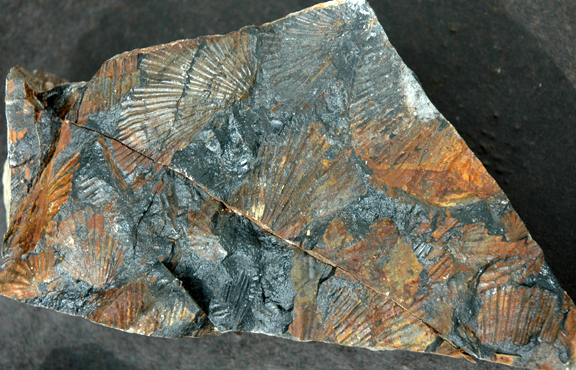
![]()

Photo 1: A plate of Monotis paper clams from the late Triassic.
Late Triassic Paper Clams of the Monotis Genus
Though Vancouver Island is famous for its Cretaceous fossil beds, across North Vancouver Island, there are also pockets of fossiliferous rock deposited during the late Triassic Period. Paper Clams, especially of the Monotis genus, are common in these beds.
My introduction to these thin-shelled bivalves came while camping on the Upper Campbell Lake near the old wooden trestle bridge, when my 6-year old son who has an excellent eye for spotting fossils in rocks, picked up a few shards on the beach. We traced these shards back to a spot just above the high water mark of the lake right next to our campsite. I didn't know it at the time, but upon further research, it became clear that the fossils were paper clams from the late Triassic. And from further research, I was able to conclude they were of the Monotis genus and some were probably from the species M. subcircularis.
Monotis means 'one-eared' and Monotis bivalves get their name because the anterior ear of the bivalve is practically absent making it appear as though only the posterior ears of Monotis bivalves are present (see linked photo for diagram). This posterior ear is smooth compared to the rest of the bivalve, which has radiating ribs like a scallop or cockle.
Because Monotis bivalves were widespread and easily identifiable, they are important for dating the relative age of the rock they are found in (as well as the co-occuring fossils in that rock).
The south side of the wooden trestle bridge that crosses the Upper Campbell Lake is an excellent place to collect some samples of this beautiful bivalve. Look above the high water mark along the shore between the bridge and the campsite. There are a few exposed veins, but you will probably have to dig to find a vein that isn't rotten. Unfortunately, the rock is as likely to fracture across the fossils as along the plane of sedimentation making it hard to get complete specimens.
Gallery of Select Images of Monotis Paper Clam Bivalves from the late Triassic:
Reference: The Late Triassic Bivalve Monotis in Accreted Terranes of Alaska. This U.S. Geological Survey article is an excellent reference on Monotis bivalves. Though the research is centered on Alaska, much of the information is relevant for Vancouver Island as part of Alaska belonged to Wrangellia. There are excellent photograph plates and descriptions of the various species including M. subcircularis, which is common on North Vancouver Island.
